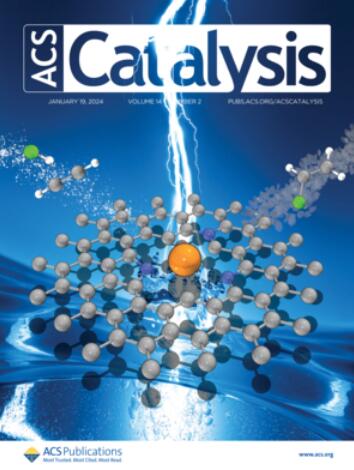Optimal Solution for Modeling Electrocatalysis on Two-Dimensional Single-Atom Catalysts with Grand Canonical DFT
IF 11.3
1区 化学
Q1 CHEMISTRY, PHYSICAL
引用次数: 0
Abstract
Single-atom catalysts (SACs) have received great attention due to their exceptionally high metal atom utilization and outstanding catalytic activity. In this work, the potential-dependent reaction kinetics of the hydrogen evolution reaction on single-atom catalysts have been investigated. The appearance of the “potential shift” effect in canonical DFT within the charge-neutral model (CNM) and the “charge shift” effect in grand canonical DFT within the constant-potential model (CPM), caused by the difference in the strength of the substrate–adsorbent interaction, is schematically illustrated. The origins of the abnormal reaction and activation energy differences between CNM and CPM on SACs have been clearly identified. It is found that considerable “potential shift” effects or “charge shift” effects are inevitable on two-dimensional SACs due to the overestimated adsorbate–substrate interactions, which lead to unreasonable energy profiles. Here, we propose a corrective method for introducing a conductive substrate to construct supported SAC electrodes. The modified SAC models can remarkably reduce the “charge shift” effect for constant-potential energy calculations, thus providing a more accurate consideration of the electrode potential effect. This work presents an improved theoretical model for constant-potential energy simulations of SACs.

二维单原子催化剂电催化模拟的大正则DFT最优解
单原子催化剂因其极高的金属原子利用率和优异的催化活性而受到广泛关注。本文研究了单原子催化剂上析氢反应的电位依赖性反应动力学。在电荷中性模型(CNM)和恒电位模型(CPM)中,由于底物-吸附剂相互作用强度的不同而引起的“电荷位移”效应在大正则DFT中的出现。CNM和CPM在SACs上的异常反应和活化能差异的原因已经明确。研究发现,由于过高估计了吸附物与底物的相互作用,导致二维sac的能量分布不合理,因此不可避免地会产生相当大的“势移”效应或“电荷移”效应。在这里,我们提出了一种引入导电衬底来构建支撑SAC电极的校正方法。修正后的SAC模型可以显著降低恒势能计算中的“电荷移位”效应,从而更准确地考虑电极电位效应。本文提出了一种改进的sac恒势能模拟理论模型。
本文章由计算机程序翻译,如有差异,请以英文原文为准。
求助全文
约1分钟内获得全文
求助全文
来源期刊

ACS Catalysis
CHEMISTRY, PHYSICAL-
CiteScore
20.80
自引率
6.20%
发文量
1253
审稿时长
1.5 months
期刊介绍:
ACS Catalysis is an esteemed journal that publishes original research in the fields of heterogeneous catalysis, molecular catalysis, and biocatalysis. It offers broad coverage across diverse areas such as life sciences, organometallics and synthesis, photochemistry and electrochemistry, drug discovery and synthesis, materials science, environmental protection, polymer discovery and synthesis, and energy and fuels.
The scope of the journal is to showcase innovative work in various aspects of catalysis. This includes new reactions and novel synthetic approaches utilizing known catalysts, the discovery or modification of new catalysts, elucidation of catalytic mechanisms through cutting-edge investigations, practical enhancements of existing processes, as well as conceptual advances in the field. Contributions to ACS Catalysis can encompass both experimental and theoretical research focused on catalytic molecules, macromolecules, and materials that exhibit catalytic turnover.
 求助内容:
求助内容: 应助结果提醒方式:
应助结果提醒方式:


